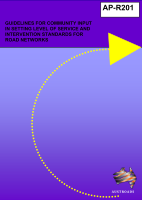Asset Management

Guidelines for community input in setting level of service and intervention standards for road networks
- Publication no: AP-R201-02
- ISBN: 0 85588 620 X
- Published: 1 January 2002
- PDF (free) Download
This report contains guidelines describing a typical community consultation process, and its application to the asset management task of defining suitable levels of service and target or intervention standards for configuration, condition, and performance of an existing road network.These guidelines are based on the premise that community consultation is fundamental to successful road asset management.The community consultation process described in this report has five distinct phases, from initial planning to implementation and review of the outcomes.The guidelines are intended to form a basis for a road agency to ascertain the expectations of local communities for a road network. The guidelines contain two questionnaires used in recent community surveys in Australia and New Zealand.To define suitable levels of service and target standards, stakeholders express their requirements of the network. Stakeholder requirements for each road category are then translated into engineering terms to produce a framework by which road-related assets can be managed.Community consultation provides opportunities for stakeholders to accept different levels of service for different roads, where it is not economically feasible or necessary to maintain the entire road network to the same standards. It is therefore appropriate to divide the road network into a hierarchy of road categories.The guidelines include a glossary of the specific terminology used.
- 1. INTRODUCTION
- 1.1. WHY OBTAIN COMMUNITY INPUT?
- 1.2. BENEFITS OF THE COMMUNITY CONSULTATION PROCESS
- 1.3. COMMUNITY CONSULTATION GUIDELINES
- 1.4. THE COMMUNITY CONSULTATION PROCESS
- 2. PHASE 1 — WORK TO BE DONE PRIOR TO COMMUNITY CONSULTATION
- 2.1. PHASE 1, STEPS 1 AND 2: IDENTIFY OBJECTIVES AND MAJOR ISSUES
- 2.2. PHASE 1, STEP 3: DEVELOP A PRELIMINARY STANDARDS FRAMEWORK
- 3. PHASE 2 — DEVELOPING THE COMMUNITY CONSULTATION PROGRAM
- 3.1. PHASE 2, STEP 1: IDENTIFY RESOURCES
- 3.2. PHASE 2, STEP 2: IDENTIFY POTENTIAL KEY STAKEHOLDERS
- 3.3. PHASE 2, STEP 3: SELECT COMMUNITY CONSULTATION TECHNIQUES
- 3.4. PHASE 2, STEP 4: FORMING A STAKEHOLDER REFERENCE GROUP
- 3.5. PHASE 2, STEP 5: MECHANISMS FOR STAKEHOLDER FEEDBACK
- 3.6. PHASE 2, STEP 6: PROGRAM TIMING
- 4. PHASE 3 — IMPLEMENTING THE COMMUNITY CONSULTATION PLAN
- 4.1. PHASE 3, STEP 1: POSSIBLE ROAD USER AND COMMUNITY EXPECTATIONS
- 4.2. PHASE 3, STEP 2: PROGRAM ADJUSTMENT
- 5. PHASE 4 — USING INFORMATION GAINED FROM THE COMMUNITY CONSULTATION PROCESS
- 5.1. PHASE 4, STEP 1: DEVELOP LEVEL OF SERVICE AND INTERVENTION STANDARDS
- 5.1.1. Condition and configuration parameters
- 5.1.2. Intervention standards
- 5.2. PHASE 4, STEP 2: IDENTIFY ISSUES
- 5.3. PHASE 4, STEP 3: TEST THE LEVEL OF SERVICE STANDARDS
- 6. PHASE 5 — ONGOING CONSULTATION
- 6.1. PHASE 5, STEP 1: ACTIVITY REPORTS
- 6.2. PHASE 5, STEP 2: STAKEHOLDER FEEDBACK
- 6.3. PHASE 5, STEP 3: ONGOING ADVISORY PANEL
- 6.4. PHASE 5, STEP 4: FINAL REPORT
- 6.5. PHASE 5, STEP 5: FURTHER COMMUNITY CONSULTATION
- 7. REFERENCES
- APPENDIX A: SAMPLE COMMUNITY QUESTIONNAIRE ON ROAD NETWORK PERFORMANCE AND STANDARDS
- REINTRODUCE IF NECESSARY
- RECORD TRANSIT REGION
- RECORD EXACT WORDS. RECORD UP TO THREE REASONS
- APPENDIX B: SAMPLE ISSUES AND DIRECTIONS PAPER
- APPENDIX C: SAMPLE QUESTIONNAIRE FOR MEASUREMENT OF CUSTOMER SATISFACTION
Related publications
Latest Asset Management News
